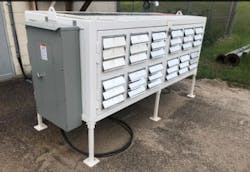A new Blockchain-Hydropower Dynamic: Focus on the Cascade Digital Power Bitcoin mining project in Wisconsin
Something old, something new, something blockchained, something turbine true.
A new company is marrying the most ancient form of power generation, still relevant today, with the most advanced computer data technology in bitcoin mining. The result is Cascade Digital Power.
Energy services provider Digital Power Optimization Inc. (DPO) created the Cascade joint venture with family-owned Wiconi Hydro. The first combination is a set of cryptocurrency mining computers housed in modular containers and fed by a repowered 6-MW hydroelectricity plant at nearby Lake Arbutus in Wisconsin.
The original facility at the Arbutus dam was created 114 years old. The zero-carbon electricity powers state-of-the-art Bitmain S19j Pro cryptocurrency mining computers at the facility operated by parent DPO.
Truly old, truly new. Full circle kind of stuff.
“I make that point frequently,” Cascade CEO Andrew Webber said in an interview with EnergyTech. “The juxtaposition is quite interesting.”
One thing Bitcoin mining is not known for is energy efficiency. In fact, the fast-growing sector requires millions of computer calculations at hyperspeed, called hash rates, working within a global network and using thousands of watthours per day per computer.
Related stories
Louisiana Cyptocurrency Mining site utilizing flexible-fuel Microturbines
Bitcoin Miner to ramp up 300-MW capacity at Michigan facility
For a more detailed analysis of what bitcoin mining is, you’ll have to find a different story. Suffice it to say for this one, though, the process is both energy draining and highly valuable, with one confirmed Bitcoin worth tens of thousands of dollars these days.
Good money, no doubt. But Webber pointed out that the fiscal part of cyptocurrency is only half of the Cascade equation.
The idea was developed in parallel fashion, as company leaders saw both concerns about the emissions impact of blockchain operations but also the opportunity for underutilized energy assets. Think of California’s vast solar arrays, the wind power in west Texas and, of course, the nations’ legacy and sometimes underappreciated hydroelectric power plants.
“The energy sector gets it wrong. They view it (Bitcoin mining) as a huge negative, consuming all this energy,” Webber said. “Society values this activity and wants to spend money on it.
“This is a fantastic tool to help them make better energy development decisions, as it relates to curtailment, storage, and transmission issues.”
In other words, if there is a power plant or renewables site with more capacity than demand, a cryptocurrency site can be a valuable off-taker. That facility needs a stable, dedicated power source, and the renewable asset needs a customer.
In Cascade’s case, it owns both ends of the transaction.
The company is looking for additional hydro sites in the future and wants to ensure that the clean energy asset is essentially co-located with the mining operation.
Cascade currently operates using shipping container-sized units which can be repositioned as needed. The Wisconsin mining site is also connected to the grid to export excess power and contains no on-site fossil-fueled gen-sets.
The sky is the limit, Webber believes. Come rain, shine or wind.
“Our hydro partners are thrilled about this,” he said. “They understand this helps them revitalize more hydro projects in more locations to help more communities.”
At the Wiconi Hydro-Lake Arbutus site in Wisconsin, the 1908-era plant was previously overhauled and utilizes two new 3-MW turbine technologies. Whatever excess power is generated—and that now is far greater capacity than it was before the joint venture and upgrading—is sold into the grid as a zero-carbon contribution.
“What is beautiful about Bitcoin mining is that it is flexible,” Webber pointed out. “The computers don’t have to run all day like a Google or Amazon data center.”
They can soak up utility-scale wind power in Texas when the western breezes are blowing steady, or when the West Coast and Great Plains sunshine is abundant.
And, for an integrated energy-mining firm, they can also shut down and sell the power when prices are higher and the electricity is most needed in the main grid.
Win-win, like hydropower finding a place to fill greater and digitalized demand, is a proposition that never completely goes out of fashion.
-- -- --
(Rod Walton, senior editor for EnergyTech, is a 14-year veteran of covering the energy industry both as a newspaper and trade journalist. He can be reached at [email protected]).
About the Author
Rod Walton, EnergyTech Managing Editor
Managing Editor
For EnergyTech editorial inquiries, please contact Managing Editor Rod Walton at [email protected].
Rod Walton has spent 17 years covering the energy industry as a newspaper and trade journalist. He formerly was energy writer and business editor at the Tulsa World. Later, he spent six years covering the electricity power sector for Pennwell and Clarion Events. He joined Endeavor and EnergyTech in November 2021.
Walton earned his Bachelors degree in journalism from the University of Oklahoma. His career stops include the Moore American, Bartlesville Examiner-Enterprise, Wagoner Tribune and Tulsa World.
EnergyTech is focused on the mission critical and large-scale energy users and their sustainability and resiliency goals. These include the commercial and industrial sectors, as well as the military, universities, data centers and microgrids. The C&I sectors together account for close to 30 percent of greenhouse gas emissions in the U.S.
He was named Managing Editor for Microgrid Knowledge and EnergyTech starting July 1, 2023
Many large-scale energy users such as Fortune 500 companies, and mission-critical users such as military bases, universities, healthcare facilities, public safety and data centers, shifting their energy priorities to reach net-zero carbon goals within the coming decades. These include plans for renewable energy power purchase agreements, but also on-site resiliency projects such as microgrids, combined heat and power, rooftop solar, energy storage, digitalization and building efficiency upgrades.

